The AC compressor on our cars has no clutch. Some vendor sites may lead you to believe otherwise. Here are a couple examples from a recent post.
http://www.carpartswarehouse.com/add.../60-01751.html
http://www.nextdayauto.com/2003-audi...3-1912403.html
On our cars, the center of the compressor pulley where a clutch normally resides is filled with a rubber and steel coupler. The coupler transfers power from the pulley to the compressor shaft. This coupler is designed to fail in the event of compressor seizure (or high torque demands which herald seizure). This protects the serpentine belt (so you can get home) and the rest of the AC system (a compressor that doesn't grenade won't spew fragments into the condenser).
The function of the clutch is handled by a swash plate internal to the compressor. Not just handled, one-upped really. Here is one of Diagnosticator’s excellent posts describing the function of the swash plate design:
http://www.audizine.com/forum/showth...=1#post5913687
Here’s a functional diagram video of a variable displacement piston pump. The Audi AC compressor falls into this category. Note that the pistons only move up and down in their sleeves, they don’t rotate about the centerline of the compressor shaft.
http://www.youtube.com/watch?v=2mh902AP7Yw
Below are pics of the internals of the worn AC pump from my 2003. This pump chewed through two couplers within a few months. The piston sleeves were gouged and many of the bearings were failing as well. The failed coupler is visible inside the pulley in the first pic. The unseen center portion of the coupler attaches to the rusty splined shaft just visible inside the compressor housing.

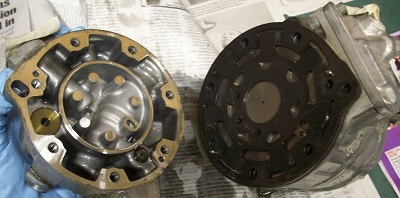
Reed plate and pistons:

Pistons unsleeved:
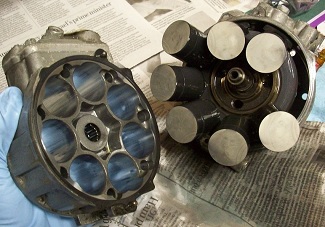
Each piston rides both sides of the swash plate on top of hemispherical pucks. In this image, the near side puck is visible under the piston. The far side puck is captured by an extended “hook” portion of the piston between the swash plate and compressor case. Whole pistons are visible in the background of later pictures.
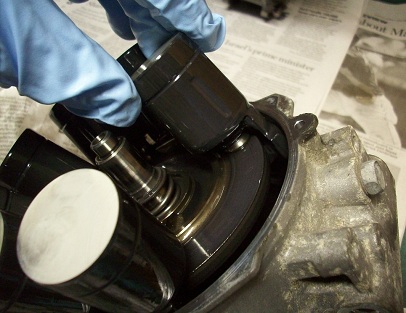
Swash plate near minimal pumping displacement. The coupler attaches to the splined shaft.
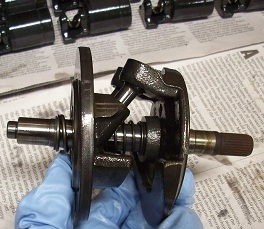
Swash plate at maximum pumping displacement:
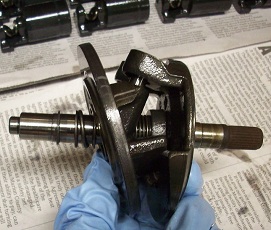
Hope this helps. Comments and feedback welcome.













 Reply With Quote
Reply With Quote I'm a big fan of knowing "how things work" and usually jump at the chance to rip apart any broken part on my car. Thanks.
I'm a big fan of knowing "how things work" and usually jump at the chance to rip apart any broken part on my car. Thanks.





 | RA4 Stage 1 w/SMFW | Milltek | Uni HFC/3'' DP Combo | 3'' TIP w/MAF | 550cc | TR1.8 FMIC | USP F/R | H-Sport F/R Sway | APR Snub | RS4 Motor Mounts | Stern Trans Mount | Skid Plate | Solid Tie Rod Ends | Short Shifter | Euro Shift Knob | VMR Boost Gauge | S4 F/R Brakes | Tyrolsport Stiffening Kit | ECS S.S. Lines | Hawk HPS Pads | 034 PCV
| RA4 Stage 1 w/SMFW | Milltek | Uni HFC/3'' DP Combo | 3'' TIP w/MAF | 550cc | TR1.8 FMIC | USP F/R | H-Sport F/R Sway | APR Snub | RS4 Motor Mounts | Stern Trans Mount | Skid Plate | Solid Tie Rod Ends | Short Shifter | Euro Shift Knob | VMR Boost Gauge | S4 F/R Brakes | Tyrolsport Stiffening Kit | ECS S.S. Lines | Hawk HPS Pads | 034 PCV


Bookmarks